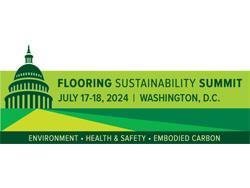Key Findings from First Flooring Sustainability Summit
Washington, DC, August 14, 2024-The Flooring Sustainability Summit brought together industry leaders, innovators, and experts to address critical challenges and opportunities in advancing sustainable building practices within the flooring sector. Two hundred and twenty-five key stakeholders convened in Washington, D.C. to discuss pressing issues and formulate actionable strategies to drive positive change across the supply chain. Day 1 of the Summit included a packed program of expert-led panel sessions and interactive workshops designed to increase dialogue across a broad group of flooring industry stakeholders. Day 2, held at the U.S. Capitol Visitor Center, included briefings by leading authorities on government procurement, green building standardization, and design specification. Here are the Summit’s top takeaways:
- Consensus on Terms and Definitions: Participants stressed the urgent need to standardize terms and definitions related to sustainability in flooring, particularly around embodied carbon. Despite significant market attention, there lacks an agreed-upon definition, and accounting methods vary widely. Clear, standardized terminology and reporting practices will improve communication and understanding across the industry.
- Radical Collaboration: Mike Johnson of the International Living Future Institute (ILFI) highlighted the importance of building partnerships and fostering open dialogue among stakeholders. More specifically, he stressed the need for “radical collaboration”. This theme resonated with other speakers and attendees. “It’s such a relief to not be talking amongst ourselves, in our own silos and disciplines,” said Cheryl Durst, CEO of the International Interior Design Association (IIDA). “If we are to solve the problems and challenges that face us as a culture, as organizations, and as an industry, we have to have these larger conversations with one another. I’m appreciative to [the Summit] for bringing us together.”
- Alignment Across the Supply Chain: There was a strong call for alignment across the entire supply chain. This includes education, simplification of terminologies, and effective communication to ensure all stakeholders are working towards common sustainability objectives.
- Demand Driver Alignment: Participants recognized the need for aligning market demands with sustainable practices. Understanding and responding to consumer preferences for environmentally friendly products will drive innovation and market competitiveness.
- Standardization Alignment: A critical focus was placed on standardization across various aspects, including cradle-to-grave sustainability assessments and owner awareness of service life impacts on both carbon footprints and fiscal accounting. “Durable, sustainable materials result in operational savings,” noted Elliot Doomes, Commissioner of the Public Buildings Service at the U.S. General Services Administration.
- Multi-Attribute Considerations: The Summit underscored the importance of considering multiple attributes in product development and design to avoid carbon tunnel vision. Manufacturers were encouraged to balance ingredients to create durable, healthy, low-carbon products, while designers should consider budget constraints, energy efficiency, aesthetics, and durability.
- Holistic Assessments: Kathleen Lane of the American Institute of Architects challenged architects to look holistically at product selection across five categories of holistic health impacts: human health, ecosystem health, climate health, social health and equity, and a circular economy. Cheryl Durst added, “Building performance transparency is now a much larger conversation, considering the context of how a building performs in its neighborhood and city. Comfort, safety, clarity, simplicity, and wherewithal are five words that will resonate over the next few years. Telling the story of carbon from a hyperlocal standpoint is also critical.”
- Role of the Distributor: Participants emphasized the critical role of distributors in the supply chain, highlighting their responsibility in effectively promoting and delivering sustainable flooring solutions to the market.
- Relationships Matter: The Summit concluded on the significance of fostering strong relationships throughout the industry. Collaborative relationships built on trust and shared goals will be pivotal in driving sustainable practices forward.
The Flooring Sustainability Summit provided a platform for robust discussions and actionable insights, paving the way for a more sustainable future in the flooring industry. Participants left with a renewed commitment to innovation, collaboration, and responsible stewardship of environmental resources.
Following the event’s success, the 2025 Flooring Sustainability Summit has been announced for July 16 to 17, 2025 in Washington, D.C.
Related Topics:The American Institute of Architects
